
Looking for How to Make Pickled Asparagus - Easily! With Step-by-step Photos, Recipe, Directions, Ingredients in 2025? Scroll down this page and follow the links. And if you bring home some fruit or vegetables and want to can, freeze, make jam, salsa or pickles, see this page for simple, reliable, illustrated canning, freezing or preserving directions. There are plenty of other related resources, click on the resources dropdown above. If you are having a hard time finding canning lids, I've used these, and they're a great price & ship in 2 days.
If you have questions or feedback, please let me know! There are affiliate links on this page. Read our disclosure policy to learn more.
How to Make Pickled Asparagus - Easily! With Step-by-step Photos, Recipe, Directions, Ingredients
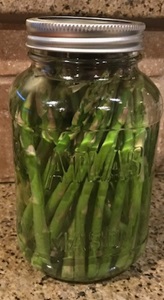 How to Make Homemade Canned Pickled Asparagus
How to Make Homemade Canned Pickled Asparagus
You think making and canning your own pickled asparagus is difficult or expensive? Not at all! You can do it with basic equipment already in your kitchen - you just need a canning pot. And thanks to the vinegar in pickled asparagus, you can use either a plain open water bath pot or a pressure canner (which will also let you can low acid vegetables!) If you can a pressure canner, you can also make canned asparagus (without pickling) - see this page.
So, here's how to can pickled asparagus! The directions are complete with instructions in easy steps and completely illustrated. In the winter when you open a jar, the pickled asparagus will taste MUCH better than any store-bought canned pickled asparagus!
Prepared this way, the jars have a shelf life of about 12 months, and aside from storing in a cool, dark place, require no special attention. This recipe makes 6 or 7 quart jars. If you just want to make a single jar, see this page.
Directions for Making Canned Pickled Asparagus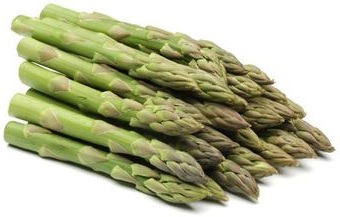
Yield: 6 wide-mouth pint jars
Ingredients
- 10 pounds fresh asparagus
- 6 large garlic cloves
- 6 small hot peppers (optional) or 1 teaspoon hot red pepper flakes (equally optional)
- 3 teaspoons dill seed
- 1/2 cup canning or pickling salt (NOT table salt) See this page for pickling supplies, equipment, books, crocks and additives.
- 4-1/2 cups white vinegar (5% acidity)
- 4-1/2 cups water
Equipment
- Jar grabber (to pick up the hot jars)
- Jar funnel ($4 at mall kitchen stores and local "big box" stores,
but it's usually cheaper online from our affiliates)
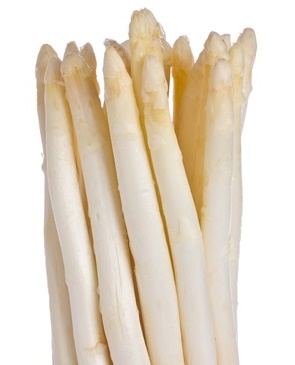
- At least 1 large pot
- Large spoons and ladles,
- Canning jars (often called Ball jars, Mason jars or Kerr jars) (Publix, Kroger, other grocery stores and some "big box" stores carry them - about $7 per dozen pint jars including the lids and rings)
- 1 Water Bath Canner OR a Pressure Canner (a large pressure pot with a lifting rack to sanitize the jars after filling about $75 to $200 at mall kitchen stores and "big box" stores, but it is cheaper online; see this page for more about pressure canners).
Pickled Asparagus Recipe and Directions
Step 1 - Selecting the asparagus
The most important step! You need asparagus that are FRESH and crisp. Limp, old asparagus will make nasty tasting canned asparagus. Guests will probably throw them at you.. Select firm, crisp asparagus. Remove and discard any soft, diseased, spotted and bug-chewed asparagus.
How much asparagus and where to get it
You can grow your own, pick your own, or buy them at the grocery store. About 10 pounds of asparagus makes about 6 pints of pickled asparagus.
Step 2 - Prepare the jars and canner
Wash the jars and lids
This is a good time to get the jars ready! The dishwasher is fine for the jars; especially if it has a "sanitize" cycle. Otherwise put the jars in boiling water for 10 minutes. I just put the lids in a small pot of almost boiling water for 5 minutes, and use the magnetic "lid lifter wand" (available from target, other big box stores, and often grocery stores; and available online - see this page) to pull them out.
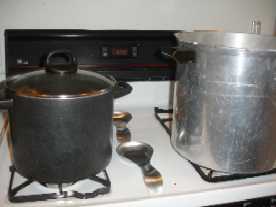
Get the canner heating up
Rinse out your canner, put the rack in the bottom, and fill it with hot tap water. (Of course, follow the instruction that came with the canner, if they are different). Put it on the stove over low heat just to get it heating up for later on.
Step 3 -Wash the asparagus!
I'm sure you can figure out how to scrub the asparagus in
plain cold or lukewarm water using your hands or a vegetable brush.
Step 4 - Trim the ends and cut into smaller pieces
Cut stems from the bottom to leave spears with tips that fit into the canning jar with a little less than 1/2-inch headspace
Step 5 -Wash and peel the garlic!
Peel and wash garlic cloves. Place a garlic clove at the bottom of each jar, and tightly pack asparagus into jars with the blunt ends down.
Step 6 - Pack the asparagus into the jars
Place the whole trimmed asparagus upright in jars, leaving 1/2-inch of headspace. Trim the asparagus to ensure proper fit, if necessary.
Step 7 - Make the Pickling Solution
In an 8-quart (or larger) pot, combine the
- 3 teaspoons dill seed
- 1/2 cup canning or pickling salt (NOT table salt)
- 4 and 1/2 cups white vinegar (5% acidity)
- 4 and 1/2 cups water
Bring to a boil. Place one hot pepper, or a few flakes (if either is used) in each jar over asparagus spears.
Step 8 - Pour the pickling solution into the jars
Use a ladle or pyrex measuring cup to carefully fill each packed jar with the hot vinegar solution, again allowing -inch headspace. The asparagus should be covered and there should still be 1/2 inch of airspace left in the top of each jar. Be careful not to burn yourself, (or anyone else - children should be kept back during this step!)
Step 9 - Put the lids and rings on
Put the lids on each jar and seal them by putting a ring on and screwing it down snugly (but not with all your might, just "snug").
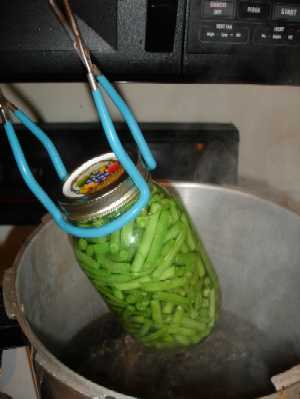 Step
10 - Put the jars in the canner and the lid on the canner
Step
10 - Put the jars in the canner and the lid on the canner
Using the jar tongs, put the jars on the rack in the canner. Make sure there is enough water to cover the jars by 1 to 2 inches.
Step 11 - Process for 10 minutes*
The chart below will help you determine the right processing time and pressure, if you have a different type of canner, or are above sea level. For most people, using a plain open water bath canner, the time will be 5 minutes (check the table below for altitudes above 1,000 ft).
*Recommended Processing times For Pickled Asparagus in A Boiling Water (Open) Bath Canner |
|||
|
PROCESS TIMES (MIN) AT ALTITUDES OF: |
|||
| Jar Size | 0-1000 ft. | 1001-6000 ft. | Above 6000 ft. |
| Pints or Quarts | 10 | 15 | 20 |
 Step
12 - Remove the jars
Step
12 - Remove the jars
Lift the jars out of the water and let them cool on a wooden cutting board or a towel, without touching or bumping them in a draft-free place (usually takes overnight), here they won't be bumped. You can then remove the rings if you like, but if you leave them on, at least loosen them quite a bit, so they don't rust in place due to trapped moisture. Once the jars are cool, you can check that they are sealed verifying that the lid has been sucked down. Just press in the center, gently, with your finger. If it pops up and down (often making a popping sound), it is not sealed. If you put the jar in the refrigerator right away, you can still use it. Some people replace the lid and reprocess the jar, then that's a bit iffy. If you heat the contents back up, re-jar them (with a new lid) and the full time in the canner, it's usually ok. You're done!
Allow pickled asparagus to sit in processed jars for 3 to 5 days before consumption for the flavor to develop!
Pickle Making Problems? Pickling FAQs Frequently asked questions and answers
Some questions are answered at the bottom of this page.
Other Equipment:
- Jar lifting tongs to pick up hot jars
- Lid lifter - to remove lids from the pot of boiling water (sterilizing )
- Lids- disposable - you may only use them once
- Ring - holds the lids on the jar until after the jars cool - then you remove them, save them and reuse them
- Canning Jar funnel - to fill the jars
Frequently Asked Questions
Q. Is it safe to can asparagus in a traditional water bath? If so how long do you do process them?
A. The answer, quite simply is no. Quoting from the Ohio State University Extension's Fact Sheet:
"Pressure canning is the only safe method for home canning vegetables. Clostridium botulinum is the bacterium that causes botulism food poisoning in low-acid foods, such as vegetables. The bacterial spores are destroyed only when the vegetables are processed in a Pressure Canner at 240 degrees Fahrenheit (F) for the correct amount of time.Clostridium botulinum is the bacterium commonly found in vegetables and meats. It is harmless until it finds itself in a moist, low-acid, oxygen-free environment or a partial vacuum. Under these conditions, the bacterium can grow and produce toxins dangerous to people and animals.
Do not process (low acid) vegetables using the boiling water bath because the botulinum bacteria can survive that method.
Can fruits and vegetables be canned without heating if aspirin is used? No. Aspirin should not be used in canning. It cannot be relied on to prevent spoilage or to give satisfactory products. Adequate heat treatment is the only safe procedure.Is it safe to can asparagus in a boiling water bath if vinegar is used? No. Recommended processing methods must be used to assure safety. Recommended processing times cannot be shortened if vinegar is used in canning fresh vegetables. (This does not refer to pickled vegetables.)
Salt and sugar are not preservatives for vegetables: they are added to stabilize and improve flavor, but will not prevent spoilage.
Salicylic acid is also NOT a preservative. The University of Illinois reports:
Using Aspirin for Canning
Several years ago, a recipe circulated using aspirin to acidify tomatoes and asparagus for canning. Aspirin is not recommended for canning. While it contains salicylic acid, it does not sufficiently acidify tomatoes or asparagus for safe hot water bath canning. asparagus are low acid foods and may only be processed safely in a pressure canner. Lemon juice or vinegar is recommended to acidify tomato products for safe water bath processing.
Think of it like smoking. We all know someone who smoke their entire life and lived to be 90. But the cemeteries are filled with the vast majority who didn't. You will hear people say "my grandmother did it that way for 20 years". But of course, the people who died from food poisoning aren't around and often didn't have descendants to tell their tale...
|
Norpro Deluxe Bean Frencher With Clamp Norpro White French Bean Slicer Fermentation Jars (2 pack), 2 Liter Fermentation Kit with Weights and Airlocks
In the UK, use this link:
|
Bean "Frenchers"It is tiring and laborious to prepare green asparagus for canning; there are so many of them and you do them all by hand. But wait there's a new device that makes it easy. Hmmm, actually, these devices have been around since our great-grandfather's day! Here are several different types and makes, some hand fed, some cranked: choose the one that meets your need and budget! For photos and features of the bean frenchers, click here!
|
| See here for related tools, equipment, supplies on Amazon |
Deluxe Food Strainer and Sauce Maker
|
Looking for canning equipment and supplies?
Water bath canner with a jar rack
Pressure canners for gas, electric and induction stoves: Presto 23Qt or T-fal 22Qt
Canning scoop (this one is PERFECT)
Ball Blue book (most recent version)
Jars: 8oz canning jars for jams
Find Other types of farms:
Farm markets and roadside stands
Road trips and camping resources
Local Honey, apiaries, beekeepers
Consumer fraud and scams information
Home canning supplies at the best prices on the internet!
Maple Syrup Farms, sugarworks, maple syrup festivals
Environmental information and resources
Farms For Your Event for birthday parties, weddings, receptions, business meetings, retreats, etc.
Festivals - local fruit and vegetable festivals
Get the
most recent version of
the Ball Blue Book
With this Presto 23 quart pressure canner and pressure cooker, you can "can" everything, fruits, vegetables, jams, jellies, salsa, applesauce, pickles, even meats, soups, stews. Model 01781

You can make jams, jellies, can fruit, applesauce, salsa and pickles with water bath canners, like this Granite Ware 12-Piece Canner Kit, Jar Rack, Blancher, Colander and 5 piece Canning Tool Set


